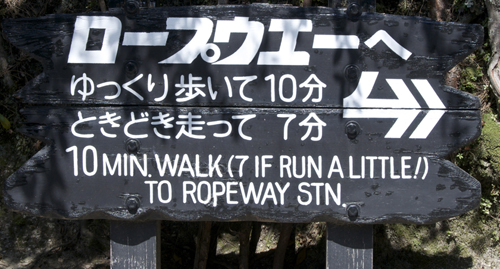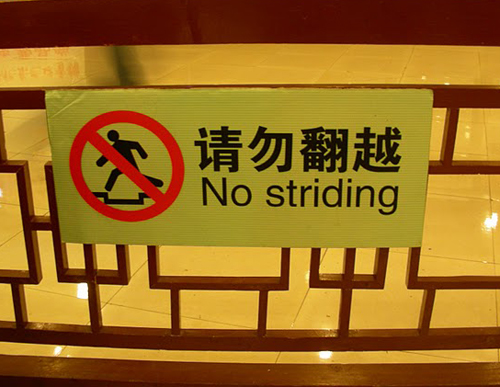156. The "Running" Radical: 走 and the Left Side of 起
The seven-stroke 走 radical may look complex, but it's simple in some ways.
Names of the 走 Radical
In English people call it the "running" radical. An alternate name is "run," which isn't a big departure!
The Japanese names depend on where the radical is located in the kanji. The basic name is はしる, which is the kun-yomi of the autonomous 走 kanji.
If the radical appears on the left side of a character, as in 起 (250: to rise, stand up; happen, occur), the name changes to そうにょう. The そう comes from the on-yomi of 走. And as you can see in the "Radical Terms" section called "Radical Positions," にょう (Position 7) is the term for radicals that enclose a character on the lower left and across the bottom.

Photo Credit: Christopher Acheson
This sign lays out your options clearly! It contrasts 歩く (あるく: to walk) with 走る (はしる: to run). The first method will take you 10分 (じゅっぷん or じっぷん: 10 minutes), the second might take only 7分 (ななふん: 7 minutes).
The Etymology of 走
To know more about the background of the "running" radical, consider the etymology of the autonomous kanji 走 (161: to run).

According to Henshall, the original shape included a "foot" more or less shaped like 止, as shown on the bottom of the ancient image above, which is the seal-script version of 走 (© Richard Sears). That meant "to move." The top part represented "a man moving frantically." As Henshall points out, "frantic movement with the feet" means "running."
Photo Credit: Eve Kushner
Sign for a Tokyo restaurant called 馳走 (ちそう: banquet, feast). The first kanji, which is non-Joyo, can mean "to run" or "to gallop" (which explains the presence of the "horse" radical, 馬). What are we to make of to run, gallop + to run in 馳走? Yes, they combine to mean "banquet, feast," but the meanings of the individual kanji leave me breathless. Are the servers constantly on the run so as to maximize profits? Is this a health food place frequented by runners? Will I feel like sprinting after I eat there? Ah, the answer turns out to be unanimous in all sources that analyze the word 馳走—namely, servers need to run around to prepare a banquet.
On the right side we find these kanji:
旬菜 (しゅんさい: seasonal dishes)
料理 (りょうり: cuisine)
So this restaurant serves seasonal dishes. Although 旬菜 is not an established word, restaurants often use it in their names. In that context, 菜 means "dish" or "meal," rather than its usual meaning of "vegetable."
The Etymology of 起
Let's consider what the "running" radical contributes to other kanji etymologically. We've already seen 起, so let's examine it more closely.
起 (250: to rise, stand up; happen, occur)
This kanji has a great etymology! The radical on the left means "to run." The part on the right represents "serpent" but also means "to stop" and "rear up" in this context. Thus, we have "to stop running and rear up," as an animal might do. This sense led to "rearing up" and then to "rise, arise, occur, cause." I can just see a snake rearing up and balancing on the tip of its "tail"!
Two with the Kun-Yomi of Omomuku
Only six Joyo kanji contain the on-duty "running" radical, and the rest divide neatly into pairs. Two have the kun-yomi of おもむく, though the Japanese no longer use the word 趣く (おもむく).
赴 (1751: to head to)
Kanjigen says that 赴 consists of 走 (to run) + the phonetic 卜 (to fall). The whole character originally meant “to rush to a place while falling several times”! It would never occur to me to represent that concept with a symbol!
趣 (1350: flavor, interest; purpose; effect, meaning; gist)
You may know this kanji from 趣味 (しゅみ: hobby), in which the on-yomi of シュ prevails. Anyway, 趣 has to do with both "running" (走) and "taking, grasping" (取). Together, these mean "running after something to take hold of it." That turned into "hurry after something," then "go in a certain direction." Now, says Henshall, 赴 usually conveys that, whereas 趣 has come to mean "incline toward; tend; tendency," as well as "gist" of an argument.
Photo Credit: Eve Kushner
The first volume of the three-volume work 1Q84 by Haruki Murakami (村上春樹, むらかみ はるき). The text in the yellow space, なにが起こっているのだろう, appears to be advertising copy on the removable obi. It translates as "What's going on?" or "What's happening?"
The Overachievers
In a final pair, both kanji are overachievers; they have meanings of "surpass, transcend, excel." Furthermore, they share the kun readings こ•える and こ•す.
越 (1021: to surpass; cross over; exceed; Vietnam)
On the left we have 走, "running." On the right is 戉, which normally means "halberd; battle ax" but acts phonetically here to express "swift" and probably also a sense of aggression. Putting these together, we have "to run swiftly" (possibly like warriors on the attack), which led to the idea of "exceeding." This extended to "crossing" and "excelling."
超 (1594: to surpass; transcend; excel; exceed; super-)
This kanji combines "to run" (走) with "to summon" (召), which acts phonetically here to express "leap high (in a dance)" and may also express "being requested (to dance)." By association, says Henshall, "running and leaping high" came to mean "going beyond a normal level," as in "exceed" and the prefix "super-."
Photo Credit: Eve Kushner
A city in Saitama Prefecture is called
川越 (かわごえ).
Photo Credit: Eve Kushner
Reading straight down the center of this saké barrel, we find 超辛口 (ちょうからくち: extra-dry alcohol), where 超- is a prefix meaning “super-,” “ultra-,” or “very.” On the right, there’s a “spring deer”: 春鹿 (はるしか: spring + deer), which must be Japan’s answer to the “spring chicken.” No, 春鹿 is the name of a saké manufacturer. On the left, we see 純米酒 (じゅんまいしゅ: saké made without added alcohol or sugar), literally meaning “pure rice saké.”

Photo Credit: Dan Farthing
No striding?! What good is it to have the "running" radical in 越 if you can't even take strides? Here's what the characters in this Chinese sign actually mean:
请勿 (please do not)
翻越 (to cross, surmount, transcend)
Apparently, the sign prohibits jumping over the fence. The crossed-out image isn't very helpful in conveying this! By the way, 请 is the simplified form of 請 (to request).
